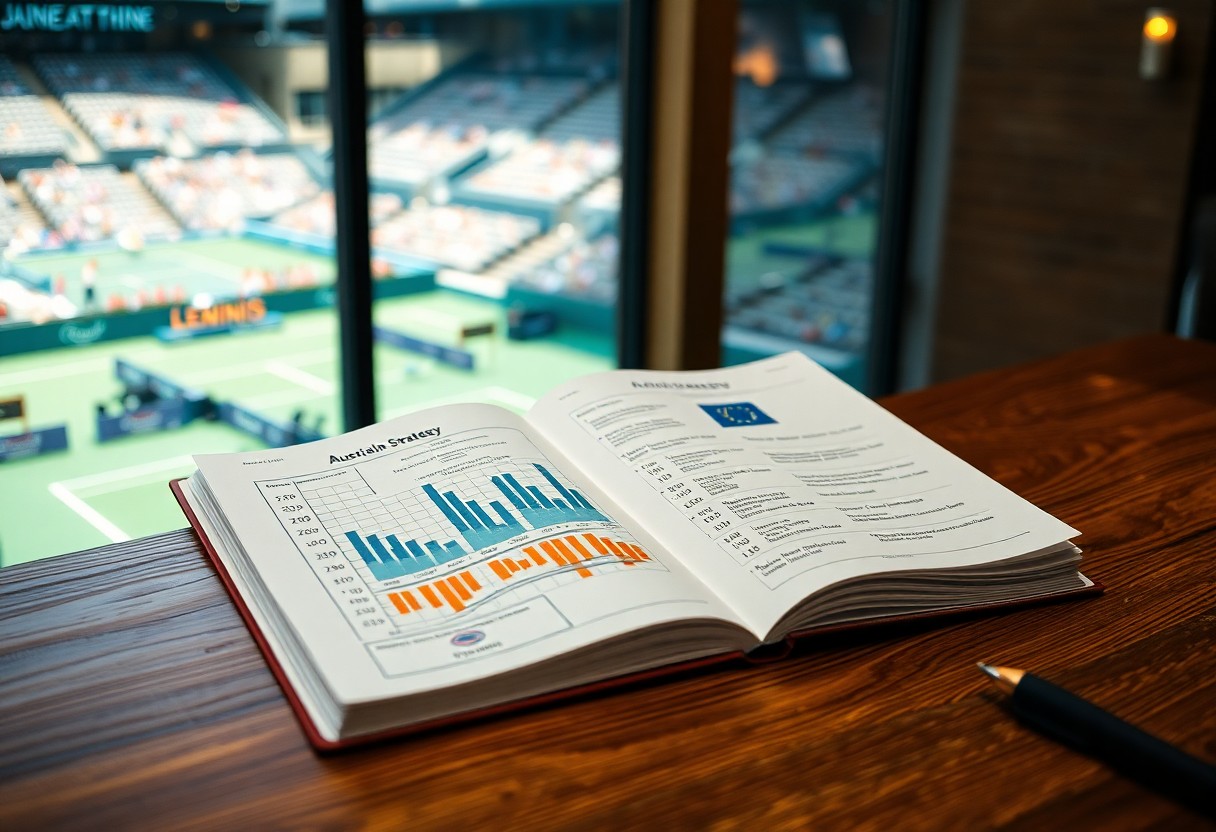Tennis bettors approaching Australian Open (wikipedia) tennis matches need a focused plan that balances analysis of player form, surface and conditions with disciplined staking; emphasize bankroll management, matching bet size to edge and avoiding tilt and chasing losses to handle variance.
Decoding the Australian Open: A Bettor’s Perspective
Court speed, scheduling and the extreme heat policy often determine market movements for tennis matches at Melbourne Park. Historical shifts from Rebound Ace to Plexicushion then GreenSet changed bounce and service advantage; long marathons like the 2012 Djokovic–Nadal final (5h53m) reshape stamina-based pricing. Sharp bettors price sessions and surface when evaluating live and outright markets.
Historical Trends and Their Impact on Betting
Bookmakers adjust lines (tennis odds) at AO using surface-era statistics and in-match fatigue signals across tennis matches; oddsmakers often shorten prices on big servers in night sessions and inflate favorites after straight-set early wins. Identifying value for underdogs in rounds 1–3 has paid off historically because favourites face scheduling and heat variability.
Key Player Formulations During the Tournament
Match scheduling, five-set workloads and prior clay or grass seasons alter player models used to price tennis matches. Big servers with first-serve percentage over 65% and high ace rates gain premiums in night sessions; returners and counterpunchers benefit on slower GreenSet surfaces. Bookmakers weight recent Australian Open form — hard-court win rate over the past 12 months and previous AO rounds — when setting pre-tournament lines. Adjust odds for recovery windows of 24–48 hours.
Detailed player formulations combine match-level metrics: average rally length, break-point conversion, serve speed, and movement efficiency; analytics often show a 10–20% swing in expected win probability when a player’s 2nd-serve points won drops by 5%. Live bettors exploit these shifts during tennis matches by targeting in-play markets after momentum breaks; monitor 2nd-serve % and break-point sequences to capture value.
Identifying Value Bets in Australian Open Tennis Matches
Compare head-to-head records, 12-month hard-court win rates and recent five-match form to spot edges in tennis matches; AO switched to GreenSet hard courts in 2020, favoring flat hitters and deep returners, so a player who holds >85% of service games on hard courts against opponents who win <50% of return games signals value. Factor in lefty vs righty patterns, fatigue from long matches, and specific AO history when pricing lines.
Leveraging Statistical Models for Predictive Insights
Use Elo and logistic regression combined with Monte Carlo simulations to convert player metrics into win probabilities for tennis matches; models that blend serve/return points won, break-point conversion and court-specific Elo can reveal when bookmakers underprice an upset by >5% implied probability.
Feed models with granular inputs: service points won, return points won, breakpoint save/convert rates, recent match length, and drift from public betting; running 10,000 Monte Carlo sims per matchup gives a stable probability distribution for tennis matches, while calibrating to live in-tournament data reduces bias—watch for overfitting to small samples and adjust priors for players with limited AO hard-court history.
The Role of Bookmaker Odds in Shaping Betting Strategies
Bookmaker odds compress public information into implied probabilities: a 1.50 decimal price implies ~66.7% probability while books typically embed a 3–6% overround. During Grand Slam weeks like the Australian Open markets tighten and liquidity rises, so spotting deviations between model probabilities and posted odds across tennis matches creates systematic opportunities for value hunting.
Understanding Market Movements and Betting Psychology
Sharp money, injury news, and crowd-driven sentiment move lines quickly in tennis matches; a first-set break can shift odds by 0.15–0.30 in decimal terms within minutes. Public bettors often overbet favorites after big-name wins, creating late-value on underdogs; observing volume, timing, and where the money originates helps distinguish genuine market correction from herd-driven spikes.
The Importance of Line Shopping for Optimal Returns
Different books can quote 1.90 versus 2.00 on the same tennis matches, a 0.10 gap that equals roughly +5.3% payout advantage for identical stakes; routinely comparing 3–5 bookmakers and an exchange prevents erosion of long-term ROI.
Use odds-comparison tools and set alerts to capture fleeting discrepancies during live tennis matches; exchanges often offer mid-market improvements and scalpers can create temporary mispricings. Allocating stakes via a Kelly fraction and favoring bets where line-shopping yields ≥0.5% edge compounds: a $100 average stake with a steady 1% edge over 1,000 bets projects $1,000 profit, showing how tiny advantages scale across volume.
Timing Your Bets: When to Stake for Maximum Edge
Australian Open runs over two weeks and lines shift dramatically after the draw, practice sessions and first-day results; watch for >5–10% price movements within 48 hours of a seeded player withdrawing. Target futures after the draw for underpriced contenders, and use opening-day markets for in-play reads—monitor player fitness and matchups across multiple courts to spot value on specific tennis matches.
Pre-Tournament Strategies vs. In-Tournament Betting
Early futures reward spotting form in warm-up events and continental hard-court results, where odds can move 20–30% once trainers report injuries; contrast that with in-tournament lines, which react to match-by-match data like first-serve percentage and break points saved. Allocate a small early stake to lock long-term value and reserve the majority for mid-tournament opportunities on individual tennis matches when live metrics are available.
Exploiting Live Betting Opportunities for Dynamic Matches
Live markets during evening sessions create the most volatility—use momentum swings, service-break sequences and real-time stat feeds to identify mispriced lines on TV court matches; bookmakers widen spreads after sudden injuries, so aggressive scalping can yield quick gains. Focus on matches with streaming and point-by-point stats to spot value in tennis matches where odds lag the on-court reality.
Monitor live tennis odds movement and set clear thresholds: consider cashing out at a locked 20–25% profit or hedging when an underdog wins two consecutive service games and drops first-serve percentage below 55%. Use small, frequent stakes on live markets for court-specific edges, and prioritize matches where line makers consistently lag streaming stats to exploit inefficient pricing in fast-changing tennis matches.
Managing Your Bankroll: Discipline in the Betting Arena
Strict staking preserves longevity across tennis matches; professional approach often limits individual bets to 1–2% of your bankroll. For a $5,000 roll that means $50–$100 stakes, keeping variance manageable through flat or proportional staking. Grand Slam volatility—long five-set swings at the Australian Open — makes conservative sizing crucial. Avoid stake escalation after losses; that behavior is the most dangerous path to ruin.
Strategies for Sustainable Wagering
Adopt a clear staking plan: flat bets, proportional (percentage of bankroll), or a fractional Kelly approach to capture value without excessive variance. Example: $1,000 bankroll, flat 1% = $10; half-Kelly can convert a theoretical edge into a modest stake.
Embracing Losses: The Psychological Component of Betting
Variance drives streaks in tennis matches; even a +5% edge can produce runs of losses. Track drawdowns and set firm stop-losses—many professionals cap weekly losses at 5–10% of bankroll. Refrain from stake escalation; chasing losses is the fastest way to convert a temporary downturn into permanent ruin. Use objective metrics like ROI and strike rate to separate skill from noise.
Loss aversion, recency bias and confirmation bias skew decisions during losing streaks in tennis matches; journaling every wager and noting market price prevents emotional throws. Simulate expected drawdowns or backtest 500+ historical matches to see stake-plan performance. Industry case: a recreational bettor who doubled stakes after three losses erased a 30% bankroll within two weeks. Implement cooling-off rules (pause after three consecutive losses or impose a 24-hour break), split stakes between pre-match and live markets, and review monthly—these are positive safeguards against the most dangerous impulses.
Conclusion
With this in mind, apply disciplined bankroll management, prioritize surface and player form analysis, use live-betting selectively, and target value markets to improve outcomes when betting on tennis matches.




